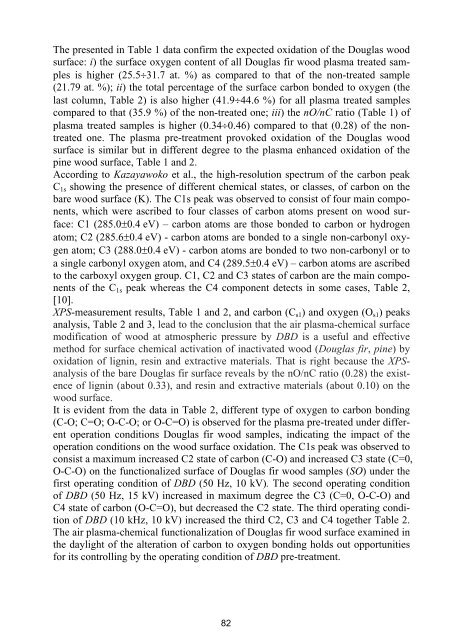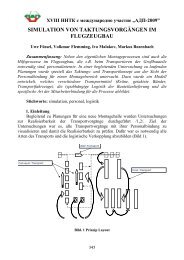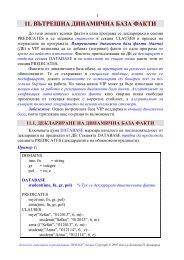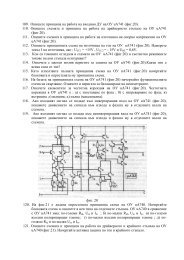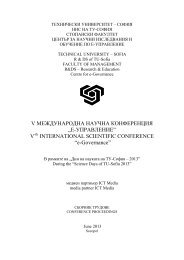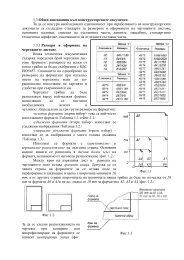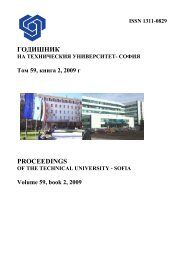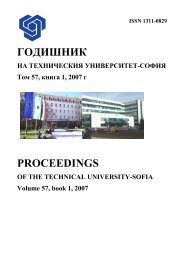Volume 61 Issue 2 (2011) - Годишник на ТУ - София - Технически ...
Volume 61 Issue 2 (2011) - Годишник на ТУ - София - Технически ...
Volume 61 Issue 2 (2011) - Годишник на ТУ - София - Технически ...
- No tags were found...
Create successful ePaper yourself
Turn your PDF publications into a flip-book with our unique Google optimized e-Paper software.
The presented in Table 1 data confirm the expected oxidation of the Douglas woodsurface: i) the surface oxygen content of all Douglas fir wood plasma treated samplesis higher (25.531.7 at. %) as compared to that of the non-treated sample(21.79 at. %); ii) the total percentage of the surface carbon bonded to oxygen (thelast column, Table 2) is also higher (41.944.6 %) for all plasma treated samplescompared to that (35.9 %) of the non-treated one; iii) the nO/nC ratio (Table 1) ofplasma treated samples is higher (0.340.46) compared to that (0.28) of the nontreatedone. The plasma pre-treatment provoked oxidation of the Douglas woodsurface is similar but in different degree to the plasma enhanced oxidation of thepine wood surface, Table 1 and 2.According to Kazayawoko et al., the high-resolution spectrum of the carbon peakC 1s showing the presence of different chemical states, or classes, of carbon on thebare wood surface (K). The C1s peak was observed to consist of four main components,which were ascribed to four classes of carbon atoms present on wood surface:C1 (285.00.4 eV) – carbon atoms are those bonded to carbon or hydrogenatom; C2 (285.60.4 eV) - carbon atoms are bonded to a single non-carbonyl oxygenatom; C3 (288.00.4 eV) - carbon atoms are bonded to two non-carbonyl or toa single carbonyl oxygen atom, and C4 (289.50.4 eV) – carbon atoms are ascribedto the carboxyl oxygen group. C1, C2 and C3 states of carbon are the main componentsof the C 1s peak whereas the C4 component detects in some cases, Table 2,[10].XPS-measurement results, Table 1 and 2, and carbon (C s1 ) and oxygen (O s1 ) peaksanalysis, Table 2 and 3, lead to the conclusion that the air plasma-chemical surfacemodification of wood at atmospheric pressure by DBD is a useful and effectivemethod for surface chemical activation of inactivated wood (Douglas fir, pine) byoxidation of lignin, resin and extractive materials. That is right because the XPSanalysisof the bare Douglas fir surface reveals by the nO/nC ratio (0.28) the existenceof lignin (about 0.33), and resin and extractive materials (about 0.10) on thewood surface.It is evident from the data in Table 2, different type of oxygen to carbon bonding(C-O; C=O; O-C-O; or O-C=O) is observed for the plasma pre-treated under differentoperation conditions Douglas fir wood samples, indicating the impact of theoperation conditions on the wood surface oxidation. The C1s peak was observed toconsist a maximum increased C2 state of carbon (C-O) and increased C3 state (C=0,O-C-O) on the functionalized surface of Douglas fir wood samples (SO) under thefirst operating condition of DBD (50 Hz, 10 kV). The second operating conditionof DBD (50 Hz, 15 kV) increased in maximum degree the C3 (C=0, O-C-O) andC4 state of carbon (O-C=O), but decreased the C2 state. The third operating conditionof DBD (10 kHz, 10 kV) increased the third C2, C3 and C4 together Table 2.The air plasma-chemical functionalization of Douglas fir wood surface examined inthe daylight of the alteration of carbon to oxygen bonding holds out opportunitiesfor its controlling by the operating condition of DBD pre-treatment.82


